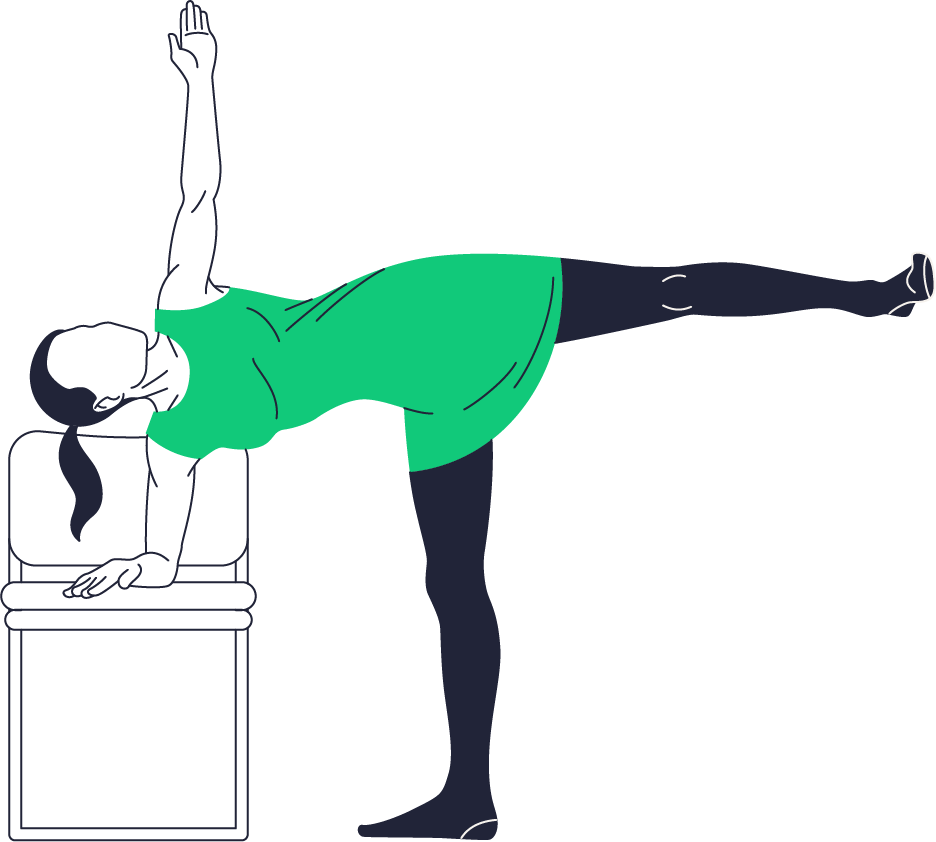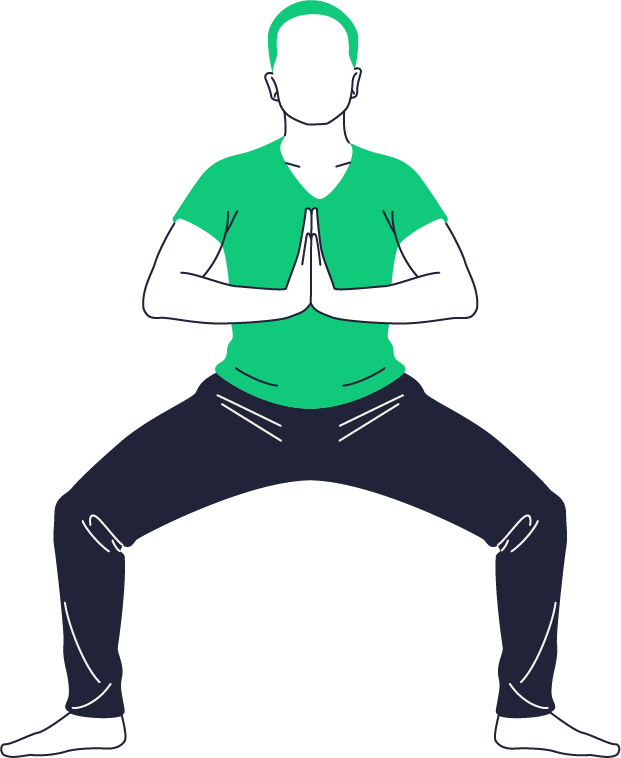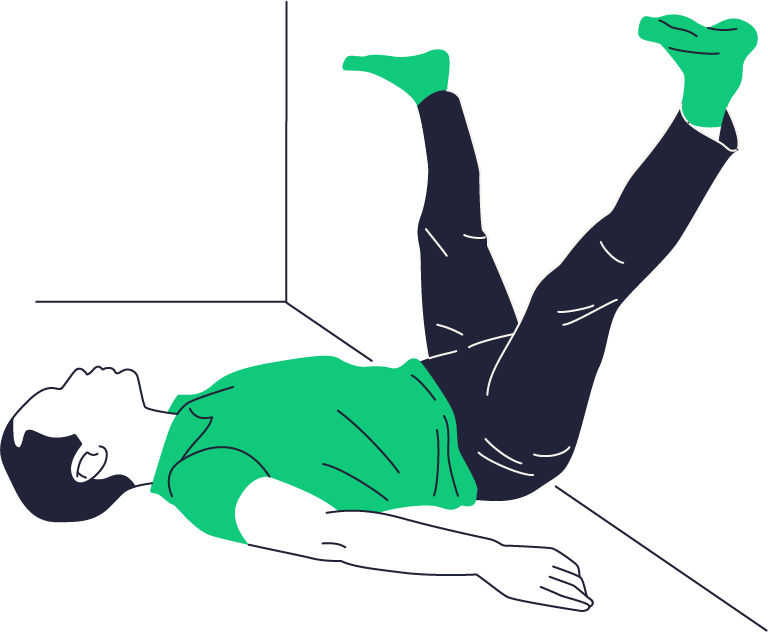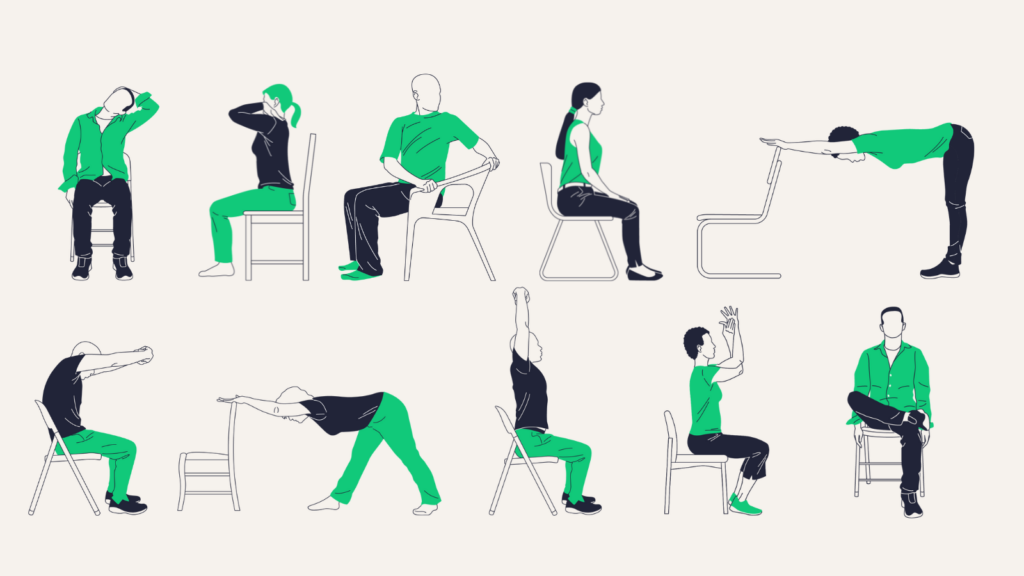The mind-body connection refers to the complex interaction between our mental and emotional states and our physical body and the suggestion that the two are interconnected and can influence each other. This concept has been recognized and explored for centuries in various cultures and practices, including traditional medicine systems like Ayurveda and Chinese medicine, as well as practices like yoga and meditation. It’s especially relevant to those of us that spend significant time at the desk as the tendency can be to “live in the head” and to ignore signals of discomfort from the body. Increasing focus on the body and its needs can have a profound effect on mental health and wellbeing.
Encourage your desk workers to boost wellbeing by exploring the mind-body connection through simple yoga practices:
Table of Contents
The science
Regular yoga practitioners find that they can improve their mental and emotional state by stretching or moving the body, and this is often a large part of what keeps them returning to the mat. The reasons for this are complex and variable, but may include:
Release of Endorphins: Physical movement, such as stretching and yoga poses, can trigger the release of endorphins in the brain. Endorphins are neurotransmitters that act as natural painkillers and mood elevators. They can reduce stress, anxiety, and depression, leading to an improved state of mind.
Activation of the Parasympathetic Nervous System: Certain yoga poses and mindful movements can activate the parasympathetic nervous system, which is responsible for the body’s relaxation response. This helps counteract the effects of the sympathetic nervous system, which is responsible for the “fight or flight” response. As a result, you may experience reduced feelings of stress and increased calmness.
Focused Attention and Mindfulness: Yoga and stretching require concentration and mindfulness as you focus on your breath, body alignment, and sensations. This focused attention can help quiet the mind, reduce mental chatter, and bring a sense of tranquility.
Can it help desk workers?
As desk workers we can “live in our heads”, spending much time entirely focussed on the screen or other inputs through our eyes and ears and become detached from the body, its needs and the signals that it may be giving us. The mind can get into spirals of negative thoughts or become overwhelmed and the emotions may tend towards stress, anxiety, irritability or low mood. The body may then reflect the emotions by tightening muscles, clenching the fists and/or jaw, or hunching into a defensive position for example, which then creates a negative feedback loop, with tension held in the body reinforcing the mental state.
We can often intuitively read someone else’s mental state from their body language – hunched shoulders, arms folded across the chest, slumped position, downward gaze and so on, but are maybe less able to recognise the same patterns in ourselves.
Tapping into the mind-body connection allows us to use simple movements, stretches or shifts in position of the body to positively affect our mental and emotional state. Below we explore 3 ways that this can be approached. Whichever method you choose, the effect will be enhanced by a focus on slowing and deepening the breath and on the physical feelings and sensations that you experience. Stay tuned in through your practice and ideally make a note on how you were feeling before and after and which poses seemed to have the greatest effect – this will help you to build your own personal mind-body connection tool kit.
3 ways to explore the mind-body connection
i. Do the opposite
When you notice that you are in a mental or emotional state that is not helpful to you, carry out a quick body scan in a seated or standing position to see how this state is reflected in your body, then systematically work through the body doing the opposite:
Is your jaw clenched? Release it and rotate the lower jaw a few times in each direction
Are your shoulders lifted? Lower them away from your ears, squeeze your shoulder blades together, release and repeat a few times
Is your head tipped forwards and your gaze downwards? Bring your head back in line with your spine and gaze out towards the horizon
Is your back hunched? Straighten up, and try a gentle backbend like one of these: Standing back bend Standing chest opener

Are your fists clenched? Spread out your fingers and stretch your hands
Is your face set into a “sad” expression? Turn up the corners of your mouth, lift the cheeks and squeeze your face into an exaggerated smile. Release and repeat a few times 😊.
Then stand in mountain pose and try to bring all of the relevant actions together. Breathe slowly and deeply for a few minutes and then assess what has changed. When you return to your day, try to remain aware of your body reverting to previous patterns and make adjustments as you need to.

ii. Reflect your ideal state
Another approach is to mirror in the body the state that you want your mental state to tend towards.
If you are feeling stressed or anxious, try mobilising the joints and stretching out the muscles to release tension from the body. Try this: At desk de-stress
If you are feeling overwhelmed, try some dynamic movement to raise your energy levels and make you feel more in control, focussing carefully on co-ordinating the movement with your breath. Try this: Knee lift to lunge Squats to tiptoe
If you are feeling down, try some poses which lift your chest, your gaze and your arms, outside if possible so that you can see the sky. Try this: Element sequence – Air
If you are feeling anxious or agitated, try some poses that make you feel stronger and more grounded. Try this: Element sequence – Earth or select the Strengthen option in the Body Focus filter in our Poses library.
If you are having difficulty coping with change, try some stretches to make your body feel more flexible. Try this: Select the Stretch/Open option in the Body Focus filter in our Poses library.
If you are having difficulty understanding another person, try some shape shifting moves to give you a change in perspective. Try one of these: Downward facing dog or Supported half moon.

If you are nervous and lacking in confidence, try some poses which build strength in the body like Plank or Horse pose.

If you can’t switch off from mental chatter, try some poses to deeply relax the body, focussing on gradually slowing and deepening the breath. Try this: Prepare to rest.

iii. Use your intuition
Set aside say 10 or 15 minutes and get into a space where you won’t be disturbed. Decide which area of your body is most affected at present by your mental state and pick a pose or two to work on this area, using the Body Area filters in our Poses library if helpful. Tune in and focus on the breath and any physical sensations. Then let your intuition guide you as to what to do next – either staying with the same body area or moving to another and focussing on what will feel good. If you move the body intuitively in ways that it needs, this is likely to benefit your mental and emotional state too.
How can Employers help?
The days of productivity being measured by reference to the number of hours at the desk are thankfully long gone. Regular movement at work, whether in the office or at home, should be encouraged and the “right to move” embedded into workplace culture, with information being provided about the positive effects that movement can have on mental health. Every individual is different, but remaining static for hours on end is likely to be a risk factor for mental as well as physical health issues. The introduction of movement into the working day can have a dramatic effect on perceived wellbeing and on productivity and effectiveness.
Conclusion
The science behind the mind-body connection and the effects of stretching or moving the body on mental well-being are well-documented. Studies have shown that activities like yoga, meditation, and other mind-body practices can lead to reduced stress, anxiety, and symptoms of depression as well as being associated with positive changes in brain structure and cognitive function. The way that the mind-body connection is experienced by each of us is of course unique and may vary day to day according to our circumstances and our underlying state of physical and mental health, but it is well worth experimenting with integrating physical movement and mindfulness practices into your day to find out what provides the most positive influences on your mental and emotional well-being and how this can enhance your .
Helen Withers, Director, YoPO Wellbeing Limited
If you would like any further information on this update or to request access to YoPO’s bank of wellbeing resources for desk workers, please contact hello@yoponow.com.
References
Here are some additional resources that may be helpful:

